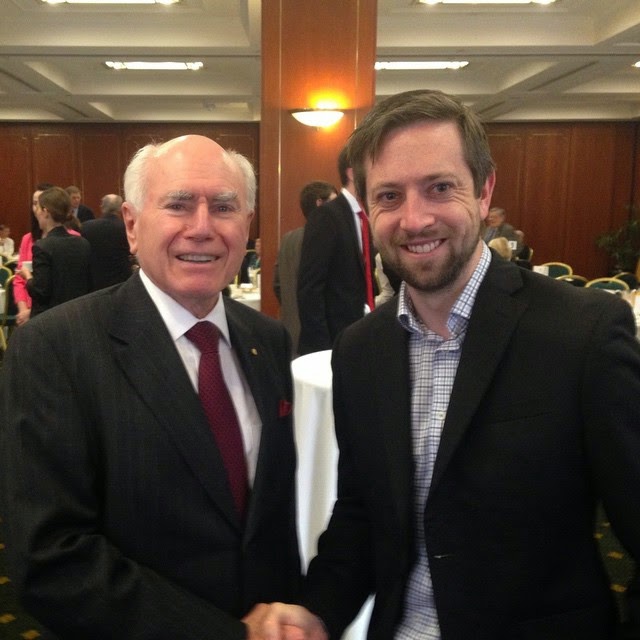Meeting a former Prime Minister
 |
| Meeting the man |
It’s not often you get to meet a former Prime Minister, but I
was fortunate enough to meet the one who, in my opinion, was the best at his
job (at least during my lifetime).
As most of you will know, John Howard was Prime Minister
of Australia from 1996 to 2007, which coincided with my time spent in high school,
university, and entry to the workforce.
As such, the Australia I know and am most familiar with
was forged with John Howard as Prime Minister, so it was with great interest
that I went to hear him speak on the launch of his new book – The Menzies Era, which explores the reign of our longest serving Prime Minister, Robert Menzies.
And it was a fascinating event. Mr Howard said that if people felt he was in
power for a long time, it was nothing compared to Robert Menzies. His party took power in 1949 and were not
voted out until 1972 – an astonishing 23 years.
Mr Howard claimed that “such longevity would be
unimaginable these days” and was likely to never be repeated in Australia.
It was, though, during these 23 years in power that Mr
Howard argues the Australia we recognise today was formed. And it was this thesis that he most wanted to
“record in persuasive detail” so that “future Australians can recognise that
during this era, the fundamental architecture of modern Australia was created.”
His perspective as a former Prime Minister no doubt gives
him a unique insight into his forbearer, and he offered a number of statistics
and factoids to support his central claim.
For example, when Menzies came to power there was 49%
home ownership in Australia; when he left it was 70%.
The ANZUS treaty was put in place in 1961, and Menzies
also signed an historic trade agreement with Japan in 1957. Interestingly, this
agreement was signed just 12 years post World War Two, when tensions between
the two nations were still high.
According to Mr Howard, when iron ore was discovered in
Australia in the 1960s, Japan was a ready and waiting trading partner due to
this agreement. Additionally, this was
when many Australian trade arrangements with Britain were beginning to lose
their currency, due to the growing influence of a European common market
But Mr Howard said, “Japan stepped in to fill the breach left
by Britain, showing that the 1957 trade agreement was a very far-sighted
one. The foresight of the Menzies
Government to secure this agreement was the entrance to the gateway of Asia for
Australia."
For me, one of the most interesting expositions offered
was on the role of the media back in Menzies’ day. Mr Howard noted that “Menzies was alive to
public opinion, but because there was no TV, the news agenda was driven by
senior press gallery figures.”
He said that Menzies, “didn't give press conferences
often because there was no need to. The media was far less ‘in your face’ than
today.”
But it was the emergence of talkback radio in the 60s that
Mr Howard argued “drove the greatest influence.” Indeed, he said, “Talkback radio remains one
of the greatest connections between politicians and the populace. And Menzies was the first to fully grasp its
influence which contributed to his longevity.”
On the future of how politicians will interact with the
media, Mr Howard offered the following insight.
“The landscape will continue to change.
The great challenge for politicians is to continually examine different
means and use them in the best way to connect with the population."
Mr Howard certainly has not lost his oratory skills; his
entire speech was delivered without notes and he made sure to make eye contact
with everyone in the room.
Indeed, you instantly recognised his skills as a
political campaigner. When he entered the
room he was sure to introduce himself to every attendee, and was more than
happy to pose for as many ‘selfies’ as anyone would wish.
Clearly, even as a former Prime Minister, John Howard
still makes it his business to try and connect with the people. And all of us in attendance were grateful for
it.

Comments